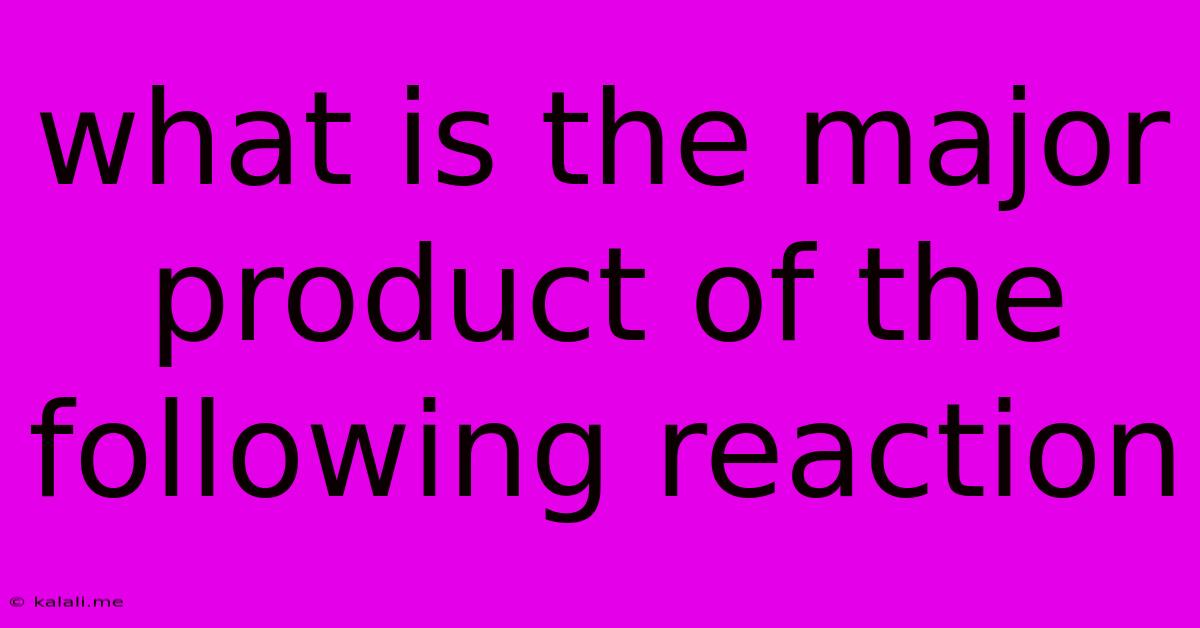What Is The Major Product Of The Following Reaction
Kalali
Jun 11, 2025 · 3 min read

Table of Contents
What is the Major Product of the Following Reaction? A Guide to Predicting Reaction Outcomes
Determining the major product of a chemical reaction is a cornerstone of organic chemistry. This article explores the key concepts and strategies for predicting the major product, focusing on common reaction types and the factors that influence product distribution. Understanding reaction mechanisms, regioselectivity, and stereoselectivity is crucial for accurately predicting outcomes. This will help you master this essential skill in organic chemistry.
Understanding reaction mechanisms is paramount. Different mechanisms lead to different products. Consider factors like carbocation stability (more stable carbocations are favored), nucleophile strength, and steric hindrance. Let's delve into some common reaction types and how to predict their major products:
SN1 and SN2 Reactions
SN1 reactions (substitution nucleophilic unimolecular) proceed through a carbocation intermediate. The rate-determining step is the formation of this carbocation. Therefore, the stability of the carbocation dictates the major product. More substituted carbocations (tertiary > secondary > primary) are more stable due to hyperconjugation and inductive effects. This means SN1 reactions favor the formation of products derived from the most stable carbocation. Consider rearrangements as well; carbocations will often rearrange to a more stable isomer.
SN2 reactions (substitution nucleophilic bimolecular) are concerted reactions, meaning bond breaking and bond formation occur simultaneously. Steric hindrance plays a significant role. Less hindered substrates react faster and are favored. Primary alkyl halides react most readily, followed by secondary, with tertiary alkyl halides generally unreactive in SN2 reactions. The nucleophile attacks from the backside of the leaving group, leading to inversion of configuration (stereochemistry).
Electrophilic Addition Reactions
These reactions are common with alkenes and alkynes. The mechanism typically involves the addition of an electrophile (positive species) to the double or triple bond, forming a carbocation intermediate (Markovnikov's rule). The nucleophile then attacks this carbocation. Markovnikov's rule states that the electrophile will add to the carbon atom with the fewest number of alkyl groups. This leads to the most stable carbocation intermediate. Exceptions can occur with anti-Markovnikov additions, often facilitated by radical mechanisms.
Elimination Reactions
Elimination reactions involve the removal of a leaving group and a proton from adjacent carbons, resulting in the formation of a double or triple bond (alkenes or alkynes). These reactions can be E1 or E2. E1 reactions (elimination unimolecular) proceed through a carbocation intermediate, similar to SN1 reactions. E2 reactions (elimination bimolecular) are concerted reactions like SN2 reactions. Zaitsev's rule often governs the major product in elimination reactions: the most substituted alkene (the one with the most alkyl groups attached to the double bond) is usually the major product. Steric hindrance, base strength, and substrate structure influence the regioselectivity and stereoselectivity in elimination reactions.
Predicting the Major Product: A Step-by-Step Approach
To accurately predict the major product, follow these steps:
- Identify the reaction type: Is it SN1, SN2, E1, E2, addition, or another type?
- Determine the mechanism: Understand the step-by-step process involved.
- Consider carbocation stability: For reactions involving carbocations (SN1, E1), prioritize the formation of the most stable carbocation intermediate.
- Account for steric hindrance: Steric effects significantly impact SN2 and E2 reactions.
- Apply Markovnikov's rule (for additions) and Zaitsev's rule (for eliminations): These rules guide the regioselectivity of the product.
- Analyze stereochemistry: Consider the inversion of configuration in SN2 reactions and the stereochemistry of the products in elimination reactions.
By carefully considering these factors, you can significantly improve your ability to accurately predict the major product of a given reaction. Remember, practice is key! Work through numerous examples to solidify your understanding. Understanding the underlying principles and mechanisms will equip you to tackle more complex reaction scenarios with confidence.
Latest Posts
Latest Posts
-
Integration By Parts Calculator Step By Step
Jun 12, 2025
-
How To Convert Octal Into Hexadecimal
Jun 12, 2025
-
Which Of The Following Is Not Correctly Matched
Jun 12, 2025
-
How To Find The Zeros Of Cubic Polynomial
Jun 12, 2025
-
Whats The Difference Between Marxism And Communism
Jun 12, 2025
Related Post
Thank you for visiting our website which covers about What Is The Major Product Of The Following Reaction . We hope the information provided has been useful to you. Feel free to contact us if you have any questions or need further assistance. See you next time and don't miss to bookmark.